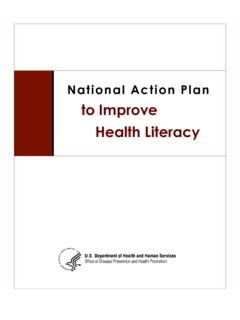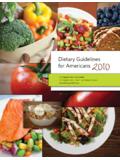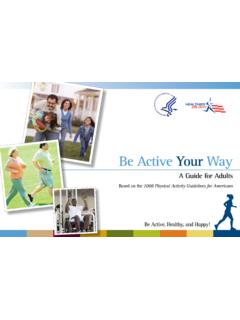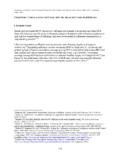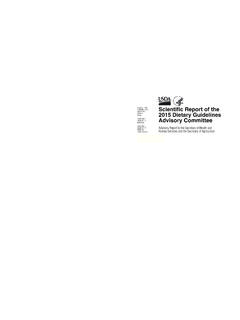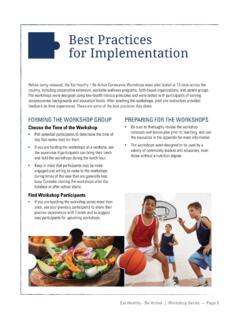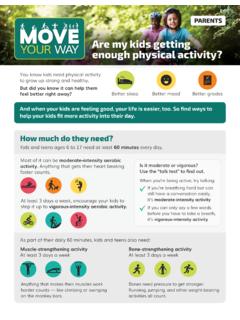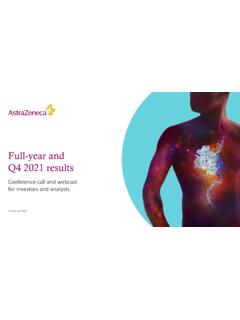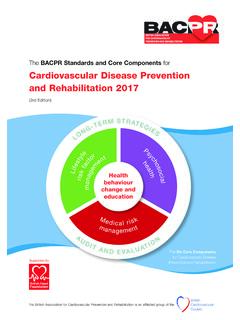Transcription of Physical Activity Guidelines for Americans 2nd edition ...
1 Introducing the Physical Activity Guidelines for Americans , 2nd edition Information adapted from the Physical Activity Guidelines for Americans , 2nd edition . Available at Information adapted from the Physical Activity Guidelines for Americans , 2nd edition . AvailableInformation adapted from the Physical Activity Guidelines for Americans , 2nd edition . Available at at Background and Development Process Information adapted from the Physical Activity Guidelines for Americans , 2nd edition . Available at History of the Physical Activity Guidelines 2008 2013 2018 Information adapted from the Physical Activity Guidelines for Americans , 2nd edition . Available at Development and Implementation of the Guidelines Appointment of PAG AdvisoryCommittee Review of the current science PAGAC Scientific Report Developmentof PhysicalActivityGuidelines Implementedin federal programs and initiatives Information adapted from the Physical Activity Guidelines for Americans , 2nd edition .
2 Available at Developing the Guidelines PhysicalActivityGuidelines for Americans , 2nd edition 2018 PAG AdvisoryCommittee Scientific Report Public comment Federal agency comment Peer review Information adapted from the Physical Activity Guidelines for Americans , 2nd edition . Available at Defining Terms Types of Activity : Aerobic Definition: o Activity in which the body s large muscles move in a rhythmic manner for a sustained period of time. Examples: o Brisk walking o Running/jogging o Swimming o Bicycling Aerobic Activity has 3 components: o Intensity, or how hard a person works to do the Activity . The intensities most often studied are moderate (equivalent in effort to brisk walking) and vigorous (equivalent in effort to running or jogging); o Frequency, or how often a person does aerobic Activity ; and o Duration, or how long a person does an Activity in any one session.
3 Information adapted from the Physical Activity Guidelines for Americans , 2nd edition . Available at Information adapted from the Physical Activity Guidelines for Americans , 2nd edition . Available at Types of Activity : Muscle-Strengthening Definition: o Physical Activity , including exercise, that increases skeletal muscle strength, power, endurance, and mass. Examples: o Lifting weights o Using resistance bands o Bodyweight exercises o Carrying heavy loads o Heavy gardening Muscle-Strengthening Activity has 3 components: o Intensity, or how much weight or force is used relative to how much a person is able to lift; o Frequency, or how often a person does muscle-strengthening Activity ; and o Sets and repetitions, or how many times a person does the muscle-strengthening Activity , like lifting a weight or doing a push-up (comparable to duration for aerobic Activity ).
4 Information adapted from the Physical Activity Guidelines for Americans , 2nd edition . Available at Types of Activity : Bone-Strengthening Definition: o Physical Activity that produces an impact or tension force on the bones that promotes bone growth and strength. o Also called weight-bearing or weight-loading Activity Note: bone-strengthening activities can also be aerobic and muscle strengthening. Examples: o Running o Jumping Rope o Lifting Weights Information adapted from the Physical Activity Guidelines for Americans , 2nd edition . Available at absolute scale: METs Relative scale: 5 or 6 on a scale of 0 to 10 Moderate Intensity absolute scale: or more METs Relative scale: begins at a 7 or 8 on a scale of 0 to 10 VigorousIntensity Defining Intensity Information adapted from the Physical Activity Guidelines for Americans , 2nd edition .
5 Available at What s New In the Physical Activity Guidelines for Americans Information adapted from the Physical Activity Guidelines for Americans , 2nd edition . Available a t What s New: Physical Activity Guidelines for Americans , 2nd edition Expanded science base New to this edition : Guidance for preschool-aged children (3-5 years) Discussion of sedentary behavior Removal of 10-minute bout length requirement Evidence for even more health benefits including immediate effects Tested strategies for Physical Activity promotion Information adapted from the Physical Activity Guidelines for Americans , 2nd edition . Available at NEW: Guidelines for Children Ages 3 Through 5 Preschool-aged children (ages 3 through 5 years) should be physically active throughout the day to enhance growth and development.
6 Adult caregivers of preschool-aged children should encourage active play that includes a variety of Activity types. Information adapted from the Physical Activity Guidelines for Americans , 2nd edition . Available at Relationship Among Moderate-to-Vigorous Physical Activity , Sitting Time, and Risk of Move More and Sit Less Sedentary behavior increases risk of: All -cause mortality cardiovascular disease mortality cardiovascular disease Type 2 diabetes Colon, endometrial, and lung cancers All -Cause Mortality in Adults Information adapted from the Physical Activity Guidelines for Americans , 2nd edition . Available at Any Activity Counts Relationship of Moderate-to-Vigorous Physical Activity to All-Cause Mortality No lower threshold for benefits from Physical Activity Most benefits are attained with at least 150-300 minutes of moderate Physical Activity per week Some health benefits are immediate Information adapted from the Physical Activity Guidelines for Americans , 2nd edition .
7 Available at Benefits of Physical Activity for Adults and Older Adults Lower risk of all-cause mortality Lower risk of cardiovascular disease mortality Lower risk of cardiovascular disease (including heart disease and stroke) Lower risk of hypertension Lower risk of type 2 diabetes Lower risk of adverse blood lipid profile Lower risk of cancers of the bladder,* breast, colon, endometrium,* esophagus,* kidney,* lung,* and stomach* Improved cognition* Reduced risk of dementia (including Alzheimer s disease )* Improved quality of life Reduced anxiety Reduced risk of depression Improved sleep Slowed or reduced weight gain Weight loss, particularly when combined with reduced calorie intake Prevention of weight regain following initial weight loss Improved bone health Improved Physical function Lower risk of falls (older adults) Lower risk of fall-related injuries (older adults)* *New health benefit Information adapted from the Physical Activity Guidelines for Americans , 2nd edition .
8 Available at Benefits of Physical Activity for Youth Improved bone health (ages 3 through 17 years) Improved weight status (ages 3 through 17 years) Improved cardiorespiratory and muscular fitness (ages 6 through 17 years) Improved cardiometabolic health (ages 6 through 17 years) Improved cognition (ages 6 to 13 years) Reduced risk of depression (ages 6 to 13 years) Information adapted from the Physical Activity Guidelines for Americans , 2nd edition . Available at New Health Benefits Improve quality of life Reduce anxiety Reduce blood pressure Improve insulin sensitivity Improve sleep outcomesLong Term Benefits For youth, improve cognition For adults, prevent 8 types ofcancer (previously 2) For adults, reduce risk ofdementia, including Alzheimer sdisease For older adults, lowers risk ofinjuries from falls For pregnant women, reduces therisk of postpartum depression.
9 For all groups, reduces the risk ofexcessive weight gainDisease management Decrease pain of osteoarthritis Reduce disease progression forhypertension Reduce disease progression fortype 2 diabetes Reduce symptoms of anxiety anddepression Improve cognition for those withdementia, multiple sclerosis,ADHD, and Parkinson s diseaseShort Term Benefits Information adapted from the Physical Activity Guidelines for Americans , 2nd edition . Available at Outcome Population Benefit Acute Habitual Improved cognition (performance on academic achievement tests, executive function, processing speed, memory) Children ages 6 to 13 years Cognition Reduced risk of dementia (including Alzheimer s disease ) Cognition Adults Adults older than age 50 years Improve cognition (executive function, attention memory, crystallized intelligence,* processing speed) Cognition Quality of life Adults Improved quality of life Brain Health Information adapted from the Physical Activity Guidelines for America ns, 2nd edition .
10 Available at Brain Health, cont. Outcome Population Benefit Acute Habitual Depressed mood and depression Children ages 6 to 17 years and adults Reduced risk of depression Reduced depressed mood Anxiety Adults Reduced short-term feeling of anxiety (state anxiety) Anxiety Adults Reduced long-term feeling and signs of anxiety disorders Improved sleep outcomes (increased sleep Sleep Adults efficiency, sleep quality, deep sleep; reduced daytime sleepiness frequency of use of medication to aid sleep Sleep Adults Improved sleep outcomes that increase with duration of acute episode What Works to Increase Physical Activity ? For Individuals or Small Groups Guidance from peers or professionals Support from others Te c h n o l o g y Point of decision prompts School policies and practicesFor Communities Access to indoor or outdoor recreation facilities or outlets Community-wide campaigns Community designInformation adapted from the Physical Activity Guidelines for Americans , 2nd ed ition.)
